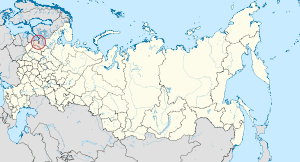Saint Petersburg: Federal city in and former capital of Russia
Saint Petersburg (Russian: Санкт-Петербу́рг, romanized: Sankt-Peterburg) is a Russian city in northwestern Russia, near the Gulf of Finland of the Baltic Sea.
Over five million people live in St. Petersburg as of 2015, and it is the second biggest city in Russia. It is a major port, connecting with the world's shipping paths through the Neva River and the Baltic.
| Saint Petersburg Санкт-Петербург (Russian) | |||
|---|---|---|---|
| — Federal city — | |||
 Clockwise from top left: Peter and Paul Fortress on Zayachy Island, Smolny Cathedral, Bronze Horseman on Senate Square, the Winter Palace, Trinity Cathedral, and the Moyka river with the General Staff Building. | |||
| |||
Coordinates: 59°56′15″N 30°18′31″E / 59.93750°N 30.30861°E | |||
| Political status | |||
| Country | Russia | ||
| Federal district | Northwestern | ||
| Economic region | Northwestern | ||
| Established | 27 May 1703 | ||
| Federal city Day | 27 May | ||
| Government (as of October 2018) | |||
| • Governor | Alexander Beglov (UR, acting) | ||
| • Legislature | Legislative Assembly | ||
| Statistics | |||
| Area | |||
| • Total | 1,439 km2 (556 sq mi) | ||
| Area rank | 82nd | ||
| Time zone(s) | MSK (UTC+04:00) | ||
| ISO 3166-2 | RU-SPE | ||
| License plates | 78, 98, 178, 198 | ||
| Official languages | Russian | ||
| Official website | |||
Part of Saint Petersburg is designated a World Heritage Site called The Historic Centre of Saint Petersburg and Related Groups of Monuments.
History
Saint Petersburg was started by the Russian Tsar, Peter I as the capital of the Russian Empire in 1703, to take the place of the earlier capital, Moscow. It was the capital of Russia until 1918. Peter the Great established Saint Petersburg as a warm-weather port in order to show Russian dominance in the Baltic and to increase trading opportunities. Peter sought to modernize Russia, therefore he tried to make Saint Petersburg as different as possible from the former capital, Moscow, by modernizing the city.
Saint Petersburg has changed its name many times. During World War I, when Russia and Germany were fighting each other, Russians thought the name Sankt Peterburg sounded too German, so Tsar Nicholas II, on August 31 (August 18, Old Style), 1914 decided that the city was renamed Petrograd. In 1918 during the Russian revolution, the Soviet capital was moved to Moscow, still the capital of Russia now.
On January 26, 1924, five days after Lenin's death, Petrograd was renamed Leningrad in his honor. During World War II, the city was surrounded by the German army and under siege for twenty-nine months until January 1944.
Leningrad again took its old name of St. Petersburg on September 6, 1991, when Russia stopped being communist. In every-day Russian, the city is often called just "Piter". The Oblast (administrative province) where the city is the capital is still called "Leningrad Oblast".
Saint Petersburg was a beautiful city planned by Peter I. There are many man-made rivers (or canals) in the city, so the city is sometimes called the Venice of the North. There are also beautiful buildings built by Russian emperors in other places of the city. Some of these buildings are the Hermitage Museum and the Winter Palace.


Geography
Saint Petersburg is located in Northwestern Federal district of Russia. The area of the city is 605.8 km². Saint Petersburg has an area called Leningrad oblast. The city has also many islands such as Vasilyevsky Island, Kotlin Island, Kamerny Island, Aptekarsky Island etc.
The climate is a humid continental.
References

This article uses material from the Wikipedia Simple English article Saint Petersburg, which is released under the Creative Commons Attribution-ShareAlike 3.0 license ("CC BY-SA 3.0"); additional terms may apply (view authors). Content is available under CC BY-SA 4.0 unless otherwise noted. Images, videos and audio are available under their respective licenses.
®Wikipedia is a registered trademark of the Wiki Foundation, Inc. Wiki Simple English (DUHOCTRUNGQUOC.VN) is an independent company and has no affiliation with Wiki Foundation.


